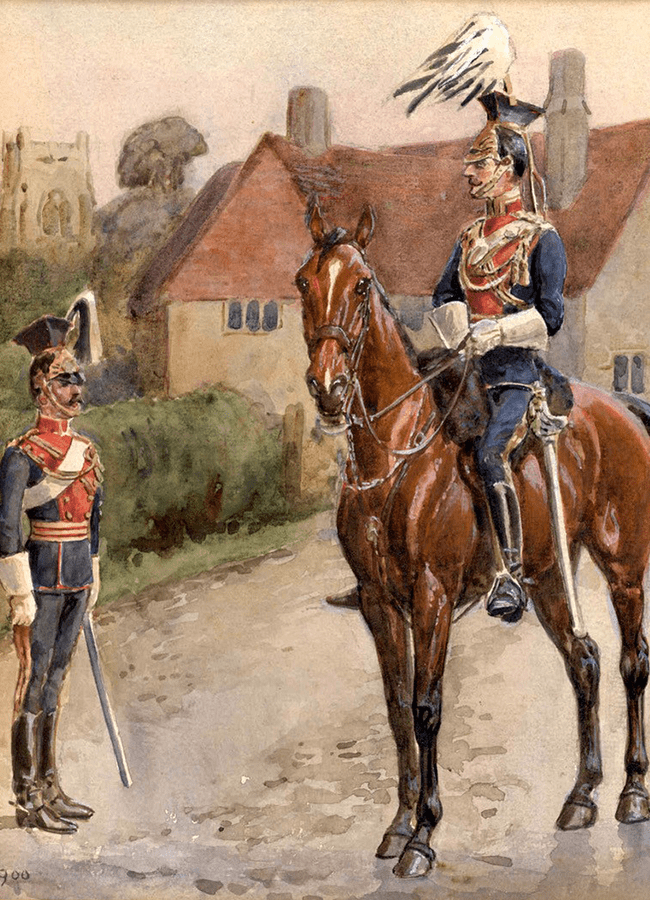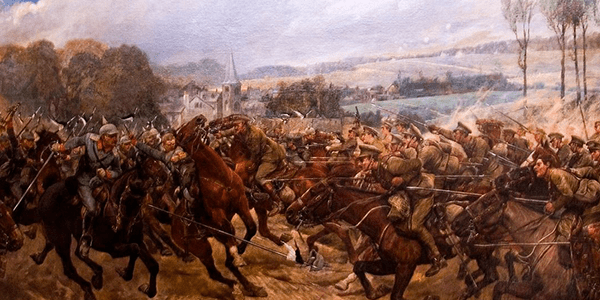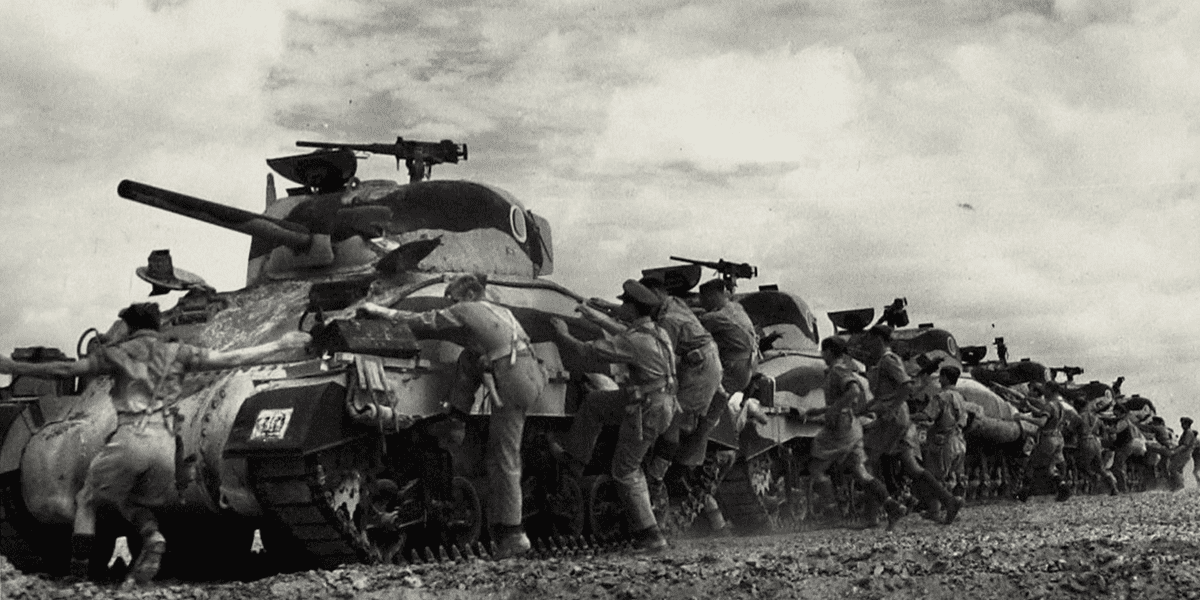9th Lancers
The Regiment of Dragoons which were later to become the 9th Queen’s Royal Lancers were raised in July 1715 as a result of the revolt of the supporters of the Stuarts against the Rule of King George I. The King had lately succeeded Queen Anne as the Protestant heir to the Throne. At this time regiments were not officially numbered, but were known by the name of their Colonel. The 9th Dragoons were raised by Major General Owen Wynne who was a veteran of Marlborough’s Wars and had distinguished records of service.
Foreign Service
The 9th were first in action and suffered casualties in the defeat of the rebel forces at Preston on the 11th November 1715. On the 25th June 1717, the 9th crossed the sea to Ireland and in 1783 the 9th became a light cavalry regiment, styled ‘The 9th Light Dragoons’. The 9th had been involved in fierce fighting in Ireland which had broken out in 1798. They were particularly praised for their conduct at the action of Three Bullet Gate.
In 1806 the 9th embarked for Foreign Service and took part in the Buenos Aires campaign in South America, being present at the taking of Montevideo. The Regiment embarked on the Walcheren Expedition in 1809. The 9th were the only cavalry regiment to disembark, and as a result, out of a total of just over 500 troops who sailed, 200 became casualties, most of them being victims of the deadly Walcheren fever.
In 1811 the Regiment sailed for the Spanish Peninsula in order to reinforce the Duke of Wellington’s Army. The 9th formed part of General Hill’s Division in the Alentejo. In their first action at Arroyo dos Molinos they captured the French general, General Bron. After the retreat from Spain to Portugal under very severe conditions, the 9th were so depleted that it was decided that they should return to England to recruit. Wellington offered “his best thanks to the Regiment for their service” and regretted that “he should be deprived of the assistance of these brave troops”.

The Three Major Actions of the Campaign
The lancer regiments of Napoleon’s Army had shown how effective cavalry regiments armed with the lance could be. In 1816 an order was published directing that the 9th Light Dragoons should be armed with the lance. In 1830 the 9th provided the escorts for King William IV on his accession. On the 22nd July the Regiment was reviewed by the King and the next day he directed that they should assume the title of the “9th Queen’s Royal Lancers”. The monogram of his Royal Consort, Queen Adelaide, still forms part of the current Regiment’s insignia.
In 1842 the 9th were sent to India and in 1843 they took part in the campaign against the Mahratta State of Gwalior. They were awarded the honour ‘Punniar’ and the men present at the battle received bronze stars made from the metal of the captured Mahratta guns. In 1845 the 9th were again on active service. They took part in the final action of the first Punjab War against the Sikhs, receiving the honour ‘Sabraon’. In 1848 war again broke out against the Sikhs. At the Battle of Goojerat on the 21st February 1849, the 9th executed a very successful charge against a large body of the Sikh cavalry, capturing two standards.
For their services in the second Punjab War the 9th received the honours ‘Punjab 1848-9’, ‘Chillianwallah’, and ‘Goojerat’.
The Regiment was in India at the outbreak of the Mutiny in 1857. The 9th was the only regiment to be present at the three major actions of the campaign, the Siege of Delhi and the Relief and Siege of Lucknow, and was awarded no less than thirteen Victoria Crosses, justifying the unique honour of a salute of twenty-one guns on their departure from India. But perhaps the greatest tribute paid to the 9th was the title ‘The Delhi Spearmen’ bestowed on them by the mutineers who had reason to fear those terrible horsemen who were described by a comrade in arms as “the beau ideal of how all the British Cavalry ought to be in Oriental countries”. For their services in the Mutiny the 9th received the honours ‘Delhi 1857’, and ‘Lucknow’.
Afghan Campaign 1879
In 1878 the 9th took part in the Afghan campaign. In October 1879 a squadron took part in the action at Charasiah. At Kila Kazi in November 1879 the Commanding Officer, Lieutenant Colonel Clelland, was mortally wounded while leading a charge. In 1880 the Regiment took part in Lord Roberts’ famous march from Kabul to Kandahar, where on the 1st September Ayub Kahn’s Army was completely routed. The 9th was awarded the honours ‘Charasiah’, ‘Kabul 1879’, ‘Kandahar 1880’, and ‘Afghanistan 1879-80’.
In 1879 Lord William Beresford of the 9th was awarded the Victoria Cross for gallantry in the Zulu War. The Regiment then fought in the South African War of 1899-1902. They took part in the Relief of Kimberley, the most brilliant cavalry exploit of the war, and the operations which resulted in Cronje’s surrender at Paardeberg. The 9th provided Lord Roberts’ escort when he made his state entry into Bloemfontein. He said, “I know they have always been a splendid Regiment and this is the third time they have been on active service with me”. The regiment was engaged in all the actions which culminated in the capture of Pretoria. For their services in South Africa the 9th received the Battle Honours, ‘Modder River’, ‘Relief of Kimberley’, ‘Paardeberg’ and ‘South Africa 1899-1902’.


Prussian Dragoons
The 9th served on the Western Front throughout the Great War of 1914-18. and on the 7th September at Moncel Lieutenant Colonel David Campbell charged at the head of RHQ and two troops of B Squadron of the 9th and overthrew a squadron of the 1st Garde Dragoner (Prussian Dragoons). This was the last significant lance against lance action of the Great War.
Earlier in the campaign on the 24th August 1914 Captain Francis Grenfell and a party of the 9th had helped to save the guns of 119 Battery Royal Field Artillery near Doubon. For this action and the charging of the unbroken line of infantry at Audregnies, Belgium, on the same day Captain Grenfell was awarded the Victoria Cross. Captain Grenfell was one of the first gazetted VCs of the Great War. He was later killed in action in 1915.
Outbreak of War 1939
During the period between the Great War and the Second World War, the 9th served in the Rhineland and Ireland and later the served in Egypt, Palestine, India, Scotland and England. During 1936 the 9th in their turn gave up their horses and the Regiment was converted to a light tank regiment.
On the outbreak of War in 1939 the 9th, as a new armoured regiment in the 2nd Armoured Brigade of the 1st Armoured Division, landed in France on the 20 March, 1940. The 9th were in action in the Somme area and were later all but surrounded at St Valery. Once the line of the Seine became untenable the 1st Armoured Division was ordered to withdraw and embark for England. The Regiment sailed for Africa with the 1st Armoured Division in September 1941 and served with the 8th Army throughout the Desert and North African Campaigns. The 9th played a leading part in the Battle of Alamein. Corporal Nicholls of B Squadron was personally congratulated by General Montgomery for knocking out nine enemy tanks in one day.

The Formation of the 9th/ 12th Royal Lancers
The 9th took a leading role in forcing the surrender of the Germans in the Cap Bon peninsula. In 1944 the regiments landed in Italy and September the 9th were in action at San Savino in the battle for the Gothic Line. The regiment was employed as infantry during the winter of 1944. In the breakthrough to the River Po in the spring of 1945, the 9th Lancers Group formed the spearhead of the 8th Army. After the War the regiment was employed on security duties in Palestine.
On its return to England in 1947 the 9th Lancers was stationed at Edinburgh for two years before moving to Germany where it were stationed at Detmold until it returned to Tidworth in 1960. The 9th were greatly honoured when Her Majesty Queen Elizabeth the Queen Mother became Colonel-in-Chief of the Regiment on the 1 June 1953.
On the 11th September 1960, the 9th Lancers and 12th Lancers marched to Church at Tidworth for the last time and, as a plaque in the Garrison Church records, “Here on the 11 September 1960, 9th/12th Royal Lancers (Prince of Wales’s) was formed by the 9th Queen’s Royal Lancers and the 12th Royal Lancers (Prince of Wale’s) coming together before God. It is not the beginning but the continuing of the same until it be thoroughly finished, which yieldeth the true glory”.
